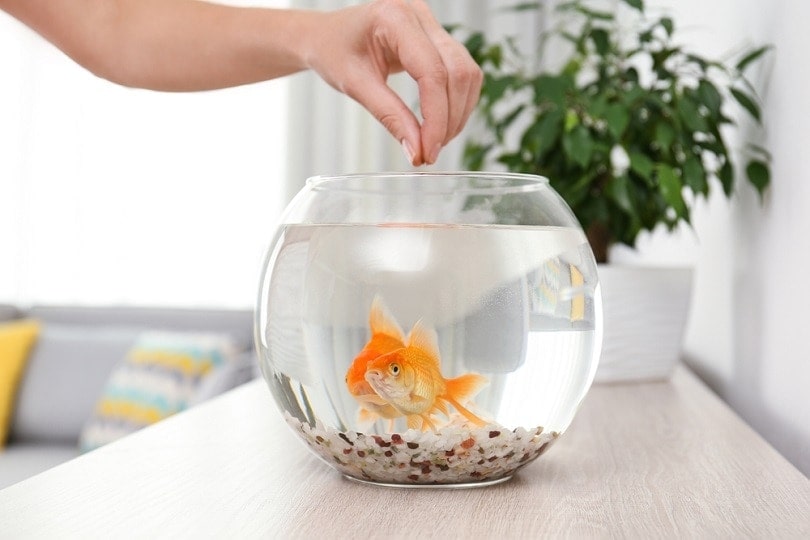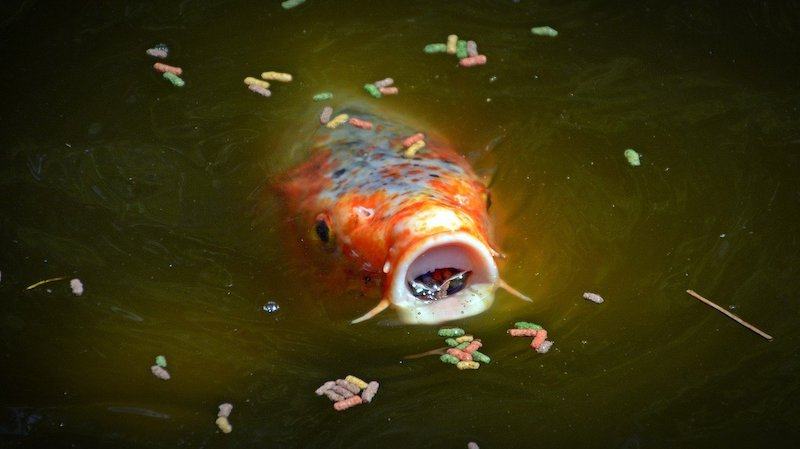Beware of These 5 Toxic Ingredients Lurking in Your Fish Food

Updated on

I’ll admit it: Packaged fish food is convenient. It doesn’t take a lot of effort and it’s usually very affordable. But, what are we REALLY feeding our pets? Are we truly giving them what’s best for their long-term health, or are we actually being sold junk food for our pets?
When picking out your next bottle of pellets/flakes/gel food, these harmful fish food ingredients should be avoided if possible. Here they are…
The 5 Ingredients to Watch Out For in Fish Food
1. Synthetic Vitamins
I want to be frank about something here. Synthetic vitamins are HUGE in the ingredients of most fish foods. Let’s use Tetra’s popular “Clear Water” goldfish food formula as an example.
We’re talking things like (the stuff underlined in red):
And they CAN WORK to prevent nutrient deficiency, initially. After that, the wheels may start coming off:
“In addition to the realization that unnatural sources of [synthetic vitamins] can be toxic, their presence can inhibit the ability of natural sources to function properly in the body. Cells have receptor sites for the attachment of biologic factors which turn on and off cellular functions. These receptors can become “clogged” with lookalike vitamins or minerals.
This phenomenon can explain why the initial consumption of a synthetic vitamin or mineral or even hormone replacement therapy works initially, when the receptor sites are empty and desperate for the nutrient. But, when the receptors become clogged with the inadequately functioning faux nutrients, the cell receptors cannot function properly. You or your pet may feel great after beginning a new synthetic supplement, or even a new type of diet, only for the original symptoms to recur after some time passes…
… Pet food costs are rising but loving pet parents have realized that healthy foods cost more and they are willing to pay for safe and effective supplements and food. As manufacturers realize there is a consumer need and willingness to purchase, they’ll respond by producing better and better pet diets.” – Dr. Jodie Gruenstern DVM CVA (Source)
I’m going to spill something right now. If any food needs a bunch of synthetic vitamins added to it, it’s probably because there was nothing nutritious about it in the first place. Why? The ingredients were probably so processed and heat-treated it was about the equivalent of CARDBOARD.
But it gets worse:
2. Preservatives

It’s true, ALL dried fish foods – be they flakes, pellets, gel food, whatever – contain preservatives. This keeps the shelf life longer and prevents the fats in the food from becoming rancid as they sit around.
But what long-term effect can this have on our pet’s health, the ones who are ingesting them?
- The preservative Ethoxyquin used specifically in pet food can cause reproductive disorders and immune-mediated diseases (when the immune system attacks the nervous system). Other than 3 spices, it’s not even allowed to be added to foods intended for human consumption!
- Potassium sorbate has the potential to mess up DNA in people (source).
- BHA and BHT are linked to causing cancer in various studies (source).
Some preservatives used in fish food are also the same ones used in human-grade food and cosmetics. And when studies have shown connections between those preservatives and disease in people, it’s not a great leap in logic to conclude it can do the same for animals.

3. Food Coloring
Especially with goldfish flakes, the use of food coloring is very prevalent. Now, what’s so bad about Yellow 5 or Blue 2 Lake? Well, these artificial colorants aren’t food – they’re chemicals. And there’s a good chance they aren’t as harmless as we once thought.
No long-term studies have been done, but some short-term ones are linking them to certain types of cancer (source).
4. Grain-Based Fillers
If the 3 ingredients above weren’t enough to turn you off to processed goldfish food or goldfish flakes, there’s more to come. Introducing fillers. These are usually things such as:
- Corn
- Soy
- Rice and rice products
- Wheat and wheat products
Aka, grains. Goldfish can’t digest grains. So, what are they doing in there? They’re used to “bulk up” the food (i.e. create more profit for manufacturers) and sometimes a binder (in the case of wheat).
But because the fish can’t digest them, this can lead to problems, especially for delicate fancy goldfish.
As the ingredients pass through the digestive tract without being broken down, they can cause constipation, intestinal impaction, and gas (often causing swim bladder problems) as the undigested food ferments in the gut of the fish.
Once excreted, they can cause cloudy or foul-smelling water. Long-term use has been linked to organ problems such as fatty liver disease. There are other ingredients that can be used as binders that are arguably better for the fish, but wheat flour is cheap.
5. Fish Meal
I’ve said it before, and I’ll say it again: Beware of fish food that contains plain ol’ “fish meal!” Not only is it made of the least nutritious, throwaway parts of the fish (bones, eyes, etc.), there’s a good chance it’s been treated with preservatives – especially Ethoxyquin – before it ever got to the fish food manufacturer (source)!
Whole fish meal is more nutritious – but it is subject to the same preservatives to prevent the fats in it from going rancid.

What Diet is The Most Ideal for Goldfish?
Honestly, it’s not anything you get off the shelf at a store. Let me repeat: There is no “perfect” packaged fish food. Some are better than others. But ALL of them have to have other stuff in them to keep their shelf life, even if the ingredients are high quality to start with.
And I have yet to see anyone using more natural preservative options. So what do you do if you want to feed your water babies only the purest, healthiest food for them? The healthiest, most natural diet for your goldfish would be comprised of insects/arthropods (for protein and amino acids) and organic veggies (for fiber and minerals).
So what does this look like in real life? In my opinion, live, frozen or dried (not freeze-dried) bloodworms, earthworms, and black soldier fly larvae (preferably organic). Then add other stuff like organic spinach, lettuce and cucumber for fiber and foraging.
Earthworms are often overlooked, but I’ve found success keeping them in shoeboxes with some soil and feeding them to the fish as needed. I order a colony online and it sustains itself while I feed it food scraps and water weekly.
For the black soldier fly larvae, I get a big bag, chop them into bits, and put them in glass jars to sprinkle like flakes. They are so nutritious too! Lest this sound far-out to you, remember that many axolotl owners feed earthworms exclusively and do the same thing as me.
One nice thing about moist foods or gently dried foods is it really keeps the digestive tract moving. Raw foods are also more nutritious and easier for your fish to digest.
- Related Post: Best Diet for Goldfish
Takeaways
This is what it all boils down to: These things are not things a goldfish would eat in the wild. And the closer you mimic their natural diet, the healthier it will be for them.
If you still want to go with commercial fish food, try to choose one that has minimal harmful ingredients. Repashy is the winner for having the least amount of junk.
Also, quick tip: Read the ingredients. Yep, chances are if you can’t pronounce it – it shouldn’t be going in your fish’s body. It doesn’t matter how beautiful the fish on the package is. It doesn’t matter how good it looks (or smells).
It doesn’t even matter if your fish really likes it (kids like candy and soda, doesn’t mean it’s a healthy diet). What matters is the quality and if there is toxic stuff in there.
Featured image credit: PxHere












